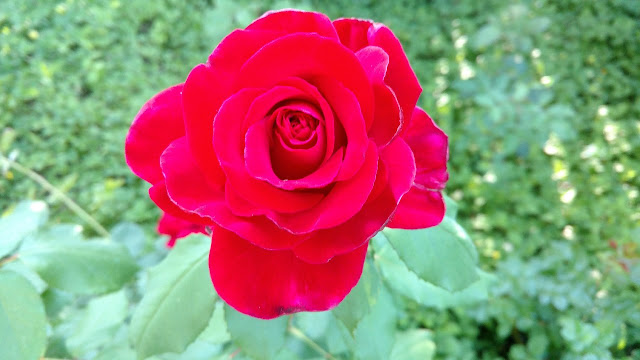
Look at the roots — if you can

|
| This beauty is an Olympiad rose. (Photo: Debbie Arrington) |
Bare-root season is when rose lovers go shopping. Now appearing in local nurseries (or coming soon) are bare-root rose bushes, ready for planting.
“Bare-root” means just what it says; the roots are bare and free from soil. Since roots will determine the strength of future growth, it’s an opportunity to check them out – as well as the above-ground portions of the plant.
These mature rose bushes, at least 2 years old and often older, were “harvested” in October or early November. That’s when they were dug out of fields, often here in California’s Central Valley. (Arizona and Texas also are major rose bush producers.) After harvest, the bushes were placed in cold (not freezing) storage with their roots loosely packed in sawdust or straw. That helps the roots retain their moisture.
Displayed in nurseries, the bare-root bushes often are still standing in sawdust. When browsing, choose a bush with at least three strong canes. Then, pull it out of the sawdust and look at the roots. Ideally, there should be at least three strong roots to match the canes above ground.
What if you can’t see the roots? That’s the case with plastic-wrapped bare-root roses, sold at nurseries as well as home improvement centers and supermarkets. That’s when you have to rely on grades.
Field-grown grafted rose bushes are graded on a scale established by the American Association of Nurseryman. “Grade 1” roses are considered the best.
Under these rules, the Grade 1 standard for hybrid teas includes at least three strong canes (with two at least 18 inches long), well spaced around the graft – where the rootstock connects to the budwood. Grade 1-1/2 roses have two strong canes. Grade 2 roses are overall smaller in size with at least two canes, 12 inches long.
Wrapped or unwrapped, what you do with that rose when you first get it home is the same: Re-hydrate it. That bush is thirsty.
Before planting your new rose bush, soak the roots in a bucket of water overnight. If weather conditions or your garden soil are too wet to plant, the bare-root bush can stay in water for several days.
For more on roses including new varieties, check out the American Rose Society website at https://www.rose.org/ .
Comments
0 comments have been posted.Sacramento Digs Gardening to your inbox.
Sites We Like
Garden Checklist for week of May 5
Survey your garden after the May 4 rainstorm. Heavy rain and gusty winds can break the neck of large flowers such as roses. Also:
* Keep an eye on new transplants or seedlings; they could take a pounding from the rain.
* Watch out for powdery mildew. Warmth following moist conditions can cause this fungal disease to “bloom,” too. If you see a leaf that looks like it’s dusted with powdered sugar, snip it off.
* After the storm, start setting out tomato transplants, but wait on the peppers and eggplants (they want warmer nights). Pinch off any flowers on new transplants to make them concentrate on establishing roots instead of setting premature fruit.
* Trim dead flowers but not leaves from spring-flowering bulbs such as daffodils and tulips. Those leaves gather energy to create next year's flowers. Also, give the bulbs a fertilizer boost after bloom.
* Pinch chrysanthemums back to 12 inches for fall flowers. Cut old stems to the ground.
* Mulch around plants to conserve moisture and control weeds.
* From seed, plant beans, beets, cantaloupes, carrots, corn, cucumbers, melons, pumpkins, radishes and squash.
* Plant onion sets.
* In the flower garden, plant seeds for asters, cosmos, celosia, marigolds, salvia, sunflowers and zinnias. Transplant petunias, zinnias, geraniums and other summer bloomers.
* Plant perennials and dahlia tubers for summer bloom.
* Don’t wait; plant summer bulbs, such as gladiolus and tuberous begonias.
* Harvest cabbage, lettuce, peas and green onions.